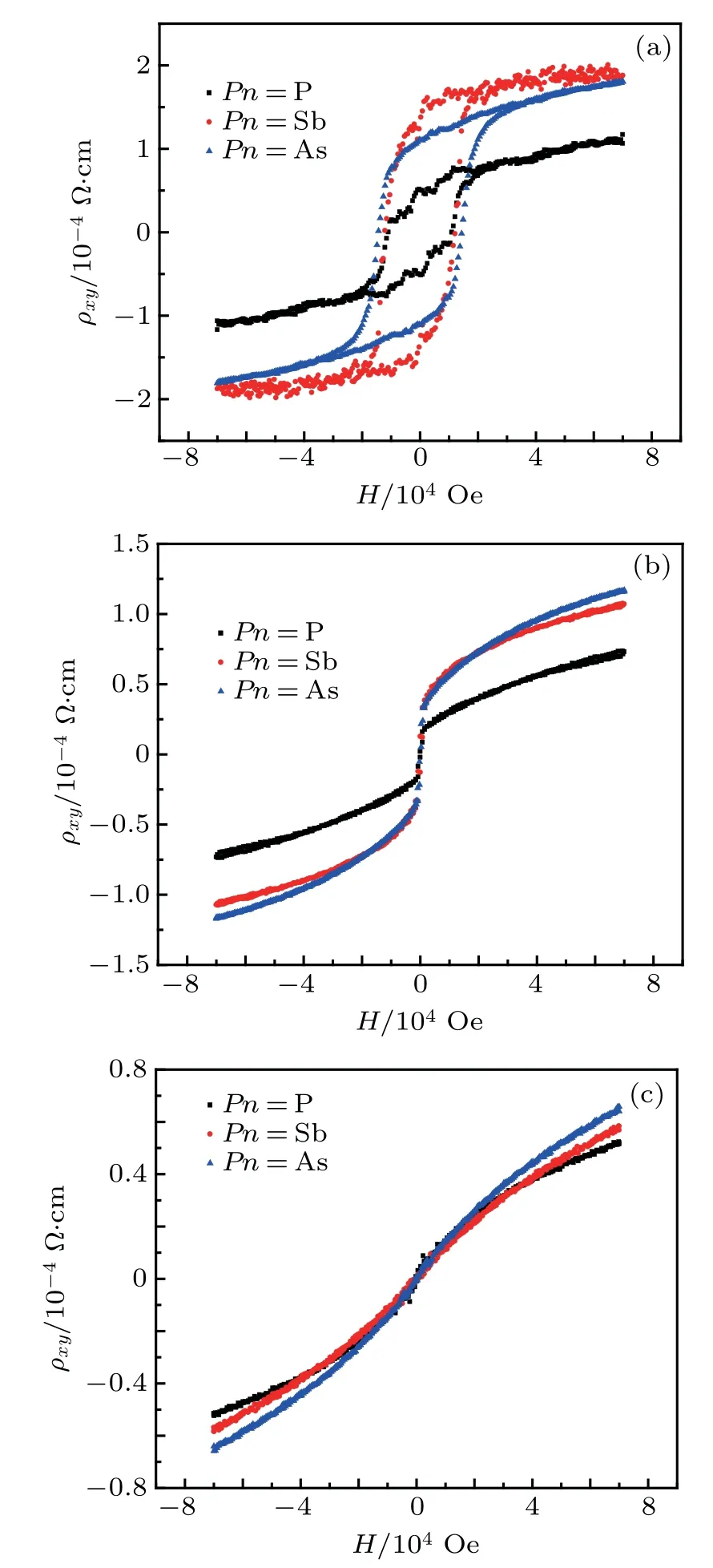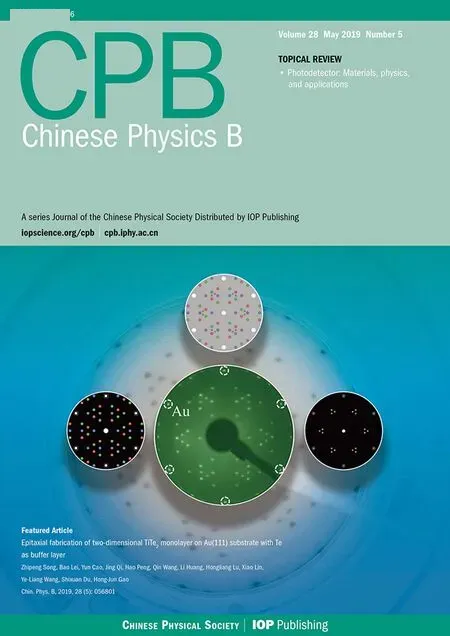Effectsof chem icalpressure on dilutedmagnetic sem iconductor(Ba,K)(Zn,M n)2As2*
Y Peng(彭毅),SYu(于爽),GQ Zhao(趙國強(qiáng)),W M Li(李文敏),JFZhao(趙建發(fā)),
L PCao(曹立朋)2,X CWang(望賢成)2,3,QQ Liu(劉清青)2,3,SJZhang(張思佳)2,3,R ZYu(于潤澤)2,3,
ZDeng(鄧正)2,3,?,X H Zhu(朱小紅)1,?,and CQ Jin(靳常青)2,3,4,§
1College ofMaterials Science&Engineering,Sichuan University,Chengdu 610064,China
2Beijing National Laboratory forCondensed MatterPhysics,and Institute ofPhysics,Chinese Academy ofSciences,Beijing 100190,China
3SchoolofPhysics,University ofChinese Academy ofSciences,Beijing 100190,China
4Collaborative Innovation CenterofQuantum Matter,Beijing 100871,China
(Received 2 February 2019;revisedmanuscript received 25 February 2019;published online4April2019)
Keywords:chemicalpressure,(Ba,K)(Zn,Mn)2As2,dilutedmagnetic semiconductor,iso-valentdoping
1.Introduction
A dilutemagnetic sem iconductor(DMS),which has potential to control charge and spin in a singlematerial,is very applicable to spintronic devices.[1–3]Since the discoveries of(Ga,Mn)As and(In,Mn)As,the III–V based DMSs have received much attention as prototypical DMS materials.[4–6]However,in either(Ga,Mn)As or(In,Mn)As,heterovalent(Ga3+,Mn2+)or(In3+,Mn2+)substitution leadsto diff iculties in individual controlof carrier and spin doping and seriously limited chemical solubility.These two obstacles prevent further improving the Curie temperature(TC)of the III–V based DMS.
Recently,a series of new DMSmaterialswith independent doping of carrier and spin have been discovered,such as Li(Zn,Mn)As and(Ba,K)(Zn,Mn)2As2(BZA).[7,8]Many progresses have beenmade in these new DMSs on both fundamental studies and potential applications.[9–28]Among the new DMSmaterials,BZA has amaximum Curie temperature(TC)of 230 K,which is a reliable record of carrier-mediated ferromagnetic DMS.[29]Large single crystals of BZA have been grown.[15]Taking advantage of single crystal-based Andreev ref lection junction,the spin polarization rate of 66%is obtained for BZA,which is comparable to prototypical III–V based DMS.[15,30]
However,the lack of reliable room temperature ferromagnetism is stillone of the open questions for all DMSmaterials.Recently,a series of studies have concentrated on physical pressure-effecton BZA to gain an insight into themechanism of the ferromagnetism in BZA and in turn to search for a possibleway to increase TC.A lthough theseworks showed suppression of TCwith increasing external pressure,onemay wonder how lattice expansion willaffect the ferromagnetism in BZA.In thisarticle,wesubstitute Aswith Sb and P to study the negative and positive chem icalpressure-effecton BZA.
2.M ethod
Two teamsof samples have been synthesized:the f irst is based on K-under-doped(Pn=Sb and P;y=0.1 and 0.2),the second is based on K-optimal-doped(Pn=Sb and P;y=0.1 and 0.2).The polycrystallines of all the sampleswere synthesized with conventional solid reaction under the protection of high-purity argon as described in Ref.[8].Powder x-ray diffraction(PXRD)was performed using Cu Kαradiation with a Philips X’pertdiffractometer at room temperature.The DCmagnetic susceptibility was characterized by a superconducting quantum interference device(SQUID)magnetometer.A physical property measurement system(PPMS)was used for electricity transport and Hall effectmeasurements.
3.Resultsand discussion
All the samples crystalize into tetrahedral BaZn2As2phase (β-phase, space group I4mmm, as shown in Fig.1(a)). Figure 1(b)shows the PXRD patterns of(Pn=Sb and P;y=0.1 and 0.2)seriessamplesas typicalexamples.Asexpected,except somem inor nonmagnetic or antiferromagnetic impurities,all the diffraction peaksmove to lower degrees with higherSb-doping leveldue to the larger ionic radiusof Sb than As.For thesame reason,P-dopingmoves thediffraction peaks to higherdegrees.Asshown in Fig.1(b),the calculated lattice parameters further demonstrate the expansion and compression of lattice by Sb-and P-doping,respectively.The lattice parametersmonotonically changewith doping levels,indicating successful chemicalsolutionsof Sb-and P-dopants.

Fig.1.(a)The crystalstructure of(Ba,K)(Zn,Mn)2(As1-yPny)2.(b)PXRD patternsof(Ba0.7K0.3)(Zn0.85Mn0.15)2(As1-yPny)2(Pn=Sb and P;y=0.1 and 0.2).Themark star stands forantiferromagnetic impurity MnAs,the solid diamond for nonmagnetic As,and theopen diamond for nonmagnetic Zn3As2.(c)Lattice constantsand cellvolumesof the samples in panel(b).

Fig.2.The temperature dependentmagnetization of(a)(Ba0.7K0.3)(Zn0.85Mn0.15)2(As1-y Pny)2(Pn=Sb and P;y=0.1 and 0.2)and(b)(Ba0.9K0.1)(Zn0.85Mn0.15)2(As1-yPny)2(y=0.1 and 0.2 for Pn=Sb;y=0.1 for Pn=P). The inset is the Curie–Weiss f it of(Ba0.7K0.3)(Zn0.85Mn0.15)2(As0.8Pn0.2)2(c)Curie temperature and paramagnetic temperature of the samples in panel(a).(d)Field dependentmagnetization of the samples in panel(a)at2K.
Figures2(a)and 2(b)show the DCmagnetization versus temperature(M(T))ofwith x=0.1,0.3; y=0.1,0.2; and Pn=Sb,P.Herein the TCofandare 70 K and 185 K,respectively,consistent with our previous report.[8]For both Kunder-doped and K-optimal-doped samples,Sb and P dopings steadily reduce TC(Fig.2(c)).The Curie–Weiss law,(χ+χ0)-1=(T-θ)/C,whereχ0is the temperatureindependent term,has been employed to f it the magnetic data above their TC.In Fig.2(c),the obtained paramagnetic temperatures(θ)share the same alteration tendency with TCfor varying Sb-and P-doping levels.Meanwhile,coercivity f ield HCand saturationmoment MSshow some nonlinear relationship upon doping,particularly in K-optimaldoped(Pn=Sb and P;y=0.1 and 0.2).In Fig 2(d),we subtract the small Hlinear component in the f ield-dependentmagnetization loops(M(H)),which is presumably due to remaining paramagnetic spins and/or f ield-induced polarization,[6]to obtain the saturation moment at 2 K.HCand MSof 10%Sb are almost identical with those of,even though the former’s TCis signif icantly lower than thatof the latter.For the P-doped samples,HCof 10%P is close to that of,but its MSis only half of the latter.W ith higher P level,both HCand MSare apparently reduced.

Fig.3.(a)(Ba0.7K0.3)(Zn0.85Mn0.15)2(As1-yPny)2(Pn=Sb and P;y=0.1)samples’temperature dependent resistivity.(b)Field dependent resistivity of the samples in panel(a)at5K.
Figure 3(a) shows the temperature dependence of resistivity,ρ(T),under H=0 T and 5 T forwith Pn=Sb,As,and P.For all the three samples,the resistivity increases with decreasing temperature,indicating a sem iconducting behavior. In the entire temperature range,the resistivity of the Sb-doped sample is much higher than that ofIn contrast,the resistivity of the P-doped sample is lower than that of(inmost range of temperature.The tendency of resistivity changingwith chemicalpressure is consistentwith our previous physical pressure studieswhich exhibited pressure induced sem iconductor–metal transition in BZA.[8,10]In this work,(As,P)substitution compresses the cellvolume,acting asa positive chem icalpressure to increase the conductivity ofIn contrary,(As,Sb)substitution,which extends the cell volume,produces a negative chem ical pressure and thus decreases the conductivity.
A ll threesamplesshow negativemagnetoresistance(MR)at low temperature regions. As shown in Fig.3(b),the hystereses(i.e.,HC)observed from theρ(H)curves ofand the Sb-doped sample are consistent with the M(H)loops,while HCof the P-doped one onρ(H)is somewhat smaller than that of the correspondingmagnetic loop.MR2K(MR def ined as(ρH-ρ)/ρ)ofis about-7%at H=5 T,consistent with the previous report.[8,9]In many ferromagnetic materials,negativemagnetoresistance results from the reduction of spin-dependent scattering by aligning the spins in the applied f ield. W ithin this scenario,compared to,thedecreaseofMR in the Sbdoped sample is reasonable as the Sb-doped one hasweaker ferromagnetic ordering.Unexpectedly,the P-doped sample showsmuch larger MR than,even TCof the former sample is smaller than thatof the latter.Magnetoresistance effect is one of themost attractive functions of spintronicmaterials or devices.Thismodif ication on MR signif icantly extends the potentialapplication of BZA.
In DMS,ferromagnetic ordering ismediated by carriers.ThusHalleffectwasmeasured to probe possible change upon Sb-or P-doping.Figure 4 shows the Hall resistivity versus f ield(ρH(H))forAs2at 2 K and(Pn=Sb,As,and P)at2 K,50 K,and 100 K.The results demonstrate hole as the major carrier for all the three samples.At 2 K,anomalous Hall effect dominates the low f ield region for each sample.The shape ofρH(H)loops is consistentwith M(H)loops at 2 K for the three samples,because the anomalous Hall part isproportional tomagnetization according to the phenomenological expression of the Hall resistivity,ρxy=R0H+RsM,where R0is the ordinary Hall coeff icient,Rsis the anomalous Hall coeff icient,and M is themagnetization.With increasing temperature,the anomalous Hall part signif icantly decreases due to theweakenedmagnetization.Hole concentrations(np)calculatedwith thedata in thehigh f ield region are tabulated in Table 1.Considering interference from remaining anomalous Hall parteven in the high f ield region,we argue that npfrom Hall resistivity of 100 K is closer to the authentic value than that form the low-temperature.The npdoes notdecrease but even slightly increases by Sb-and P-doping.Thus,the cause of the considerable reduction of TCwith Sb-and P-doping is stillan open question for future studies.

Fig.4.(Ba0.7K0.3)(Zn0.85Mn0.15)2(As1-yPny)2(Pn=Sb,As,and P;y=0.1)samples’f ield dependentHall resistivity at(a)2 K,(b)50 K,and(c)100 K.

Table 1.The hole concentrations(in units of 1020 cm-3)of(Ba0.7K0.3)(Zn0.85Mn0.15)2(As1-yPny)2 for y=0.1.
4.Conclusion and perspectives
Studiesofexternalpressure-effectson BZA revealed suppression of Curie temperature upon compression.Iso-valent substitution of Sb or P into As in BZA to produce chem ical pressure is an attractive attempt to tune themagnetic properties because previous studies on physical pressure-effects on BZA have revealed the suppression of Curie temperatureupon compression.Although lattice extension doesnot increase TCasexpected,the changeof resistivity withmodif ication of cell volume has been reproduced.Nevertheless,the large MR effect induced by P-doping offers a new boulevard to improve magnetoelectric properties for spintronicmaterials.
Acknow ledgment
Authorsaregrateful for the discussionwith Maekawa S.
- Chinese Physics B的其它文章
- Computational study of inverse ferrite spinels
- Particle–hole f luctuationsand possible superconductivity in dopedα-RuCl3*
- Surface stabilized cubic phaseof CsPb I3 and CsPbBr3 atroom tem perature*
- Raman scattering study ofmagnetic layered M PS3 crystals(M=M n,Fe,Ni)*
- Low tem perature Pmmm and C2/m phases in Sr2CuO3+δ high temperature superconductor*
- Crystallographic andmagnetic propertiesof van derWaals layered FePS3 crystal*

